Strategies for Fall and Winter Grazing: Eastern Canadian Perspectives
Editor’s note: To support current extension initiatives and provide enhanced resources, the Beef Cattle Research Council has increased collaboration and delivery of extension content that reflects the production practices and needs of Eastern Canadian beef producers. This post is part of an ongoing series of content delivery. Suggestions, ideas and comments are always welcome.
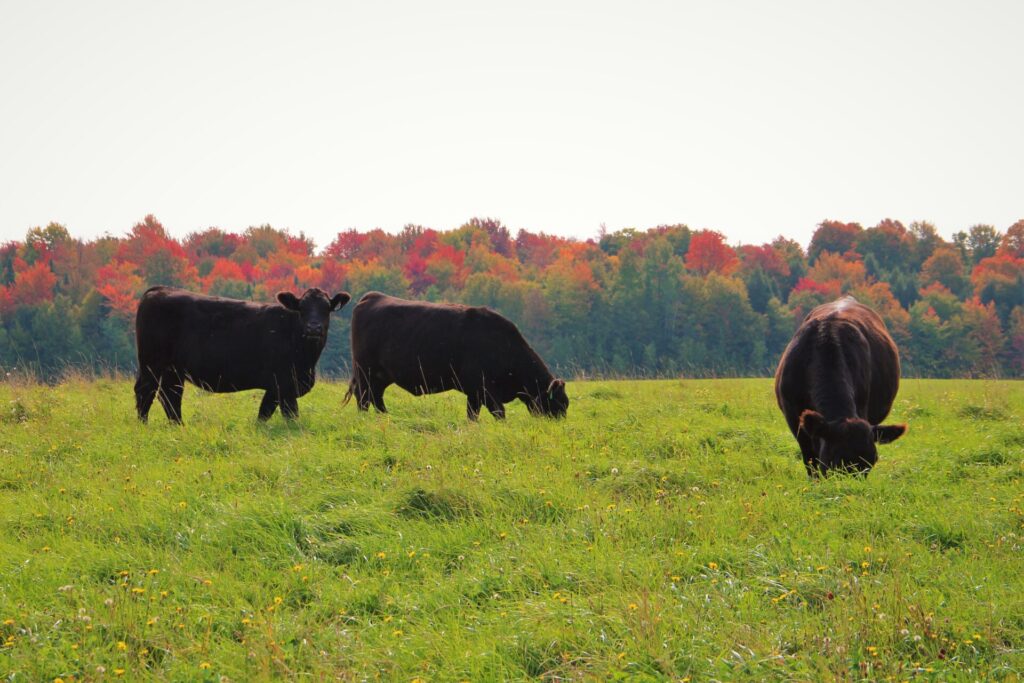
As we move into late summer, planning ahead for the coming fall and winter months is always time well spent, especially when considering the nutritional needs of the beef herd. Winter feeding can be costly and labour-intensive work.
Extending the grazing season is one way to minimize reliance on stored feeds and reduce yardage costs and labour. Depending on your unique situation, this type of management system may take on various forms. Stockpiled perennial forages, annual forages (including cover crops), crop residues and bale grazing are all options that may work on your operation.
The following producer profiles highlight some of the ways these strategies have been successfully implemented in Eastern Canada.
Manning Family Farm – Falmouth, Nova Scotia
Cover crop and corn grazing
The Manning Family Farm is located near Falmouth, Nova Scotia, and is operated by Dean and Catherine Manning and their family. They run an 80-head cow herd with split calving seasons in the late spring and early fall; they also grow field crops and vegetables. A goal on their farm is to maximize biodiversity and sustainability.
Part of their commitment to sustainable beef production is through extending their grazing season. They have been grazing stockpiled forage and standing corn for several years and this past winter experimented with grazing a cover crop cocktail mix. Cover crops are often grown for agronomic reasons—they hold on to soil, improve water infiltration and reduce runoff. However, they also provide a valuable feed source for grazing livestock, and including grazing animals in the system can help further improve the soil.
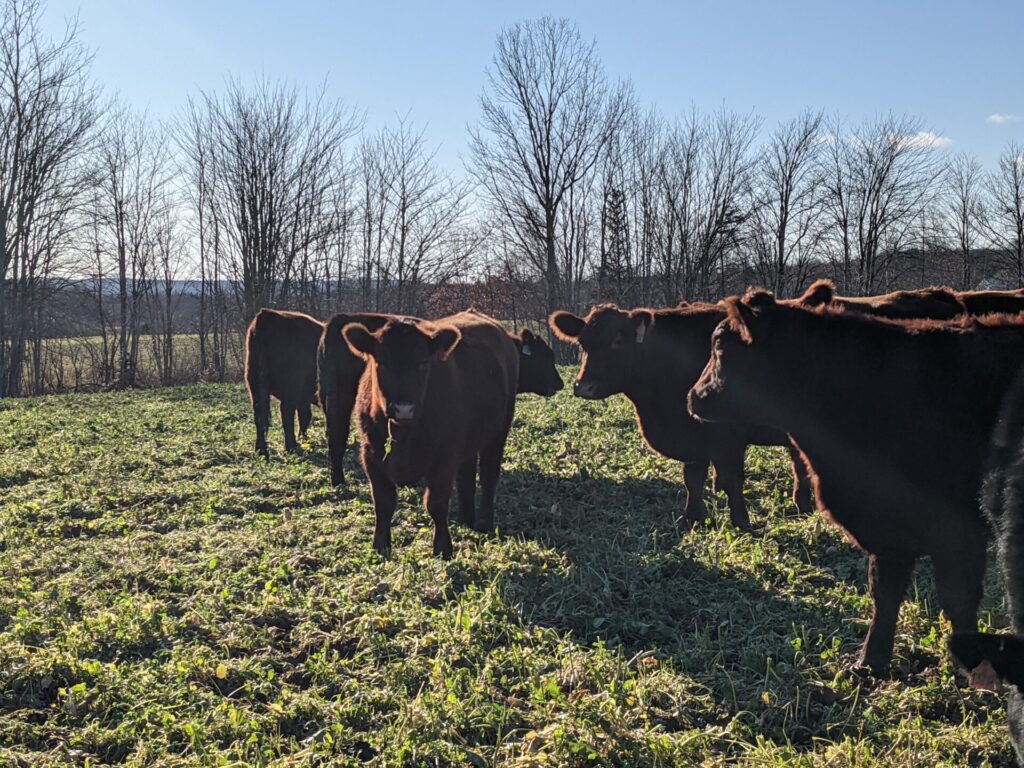
In 2021, the Mannings’ cover crop was seeded mid-August onto an 11-acre field after a crop of winter rye was harvested. The mix included fall rye (36%), Austrian winter peas (20%), hairy vetch (12%), crimson clover (10%), turnips (5%), forage kale (5%), berseem clover (5%), Nitro radish (2%), sunflowers (2%), Vivant hybrid brassica (2%) and phacelia (1%). This cocktail mix was chosen to maximize diversity within the stand.
Fifty bred heifers were turned into the field on December 2, with an average weight of 1,200 pounds. Dean reported it took approximately one week for the cows to learn how to eat the roots of the radishes and turnips.
Another benefit of grazing cover crops is annuals will usually be higher quality than what is typically available as stockpiled pasture. “I knew the feed had to be pretty good . . . they didn’t mind looking for feed in the snow,” Dean remarked. Forage samples showed 15.5% crude protein and 71% total digestible nutrient levels. There was approximately 7,300 pounds of dry matter/acre available which included both the above-ground leafy material and the turnip and radish roots. This resulted in approximately three weeks worth of grazing; the herd was able to graze the cover crop until late December. Dean reported that weeds were not a concern, likely due to the time of planting.
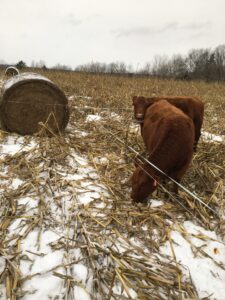
Corn grazing is another opportunity that the Mannings use to graze cattle throughout the winter. After the cattle had finished grazing cover crops this past winter, they were moved to a nearby piece of land where silage corn had been grown for the purpose of winter grazing.
The cows strip-grazed through the field and were allowed controlled access to rows of corn. Acidosis can be a concern if cows are allowed access to too much corn at once as they will selectively eat the cobs and get insufficient fibre. To mitigate this, the Mannings fed bales of hay in addition to the standing corn—at least half of the total diet. Controlled access also improved manure distribution and allowed for more uniform animal impact to trample stalks. On previous corn grazing locations, the area was replanted with a forage mix and used for harvested forage and stockpiling. This year they planted corn and brassicas where the cover crop had been grazed.
Over time, Dean is interested in seeing how winter grazing affects soil quality and continues to contribute to the sustainability of their farm. The farm meets the certified sustainable beef standards as outlined by the Canadian Roundtable for Sustainable Beef through the Verified Beef Production Plus program. The Mannings were the recipients of the Canadian Cattle Association Environmental Stewardship Award for 2021 and Nova Scotia’s Provincial Farm Environmental Stewardship Award in 2010.
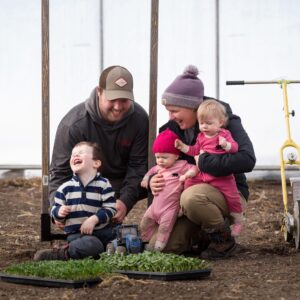
Le Paysan Gourmand – Saint-Félix-de-Kingsey, Québec
Stockpiled, corn and bale grazing
Le Paysan Gourmand is a family farm located 20 minutes from Drummondville, Québec and is run by Jacob Morin and Rosemarie Allen and their young family. They have 80 black Angus cow-calf pairs that are grazed year-round on their 300-acre farm and neighbouring cropland. In addition, they also raise pastured pork and run a market garden. Three years ago, they took over the family farm after farming alongside Jacob’s parents.
They finish their cattle on farm and sell half of their product direct to consumer as grass-fed beef and the other half to a retailer in Montreal. They also sell purebred black Angus heifers and bulls that have been proven for grass-based systems. In the past, they have had Salers and Simmental as well but feel that the smaller frame size and large rumen capacity of Angus works well for their operation.
Their motivations to keep cattle outdoors year-round include improved animal health and increased profit margins, in addition to environmental sustainability. The barn on their property is an old dairy barn “with terrible ventilation,” Jacob says. They also see reduced costs by not operating their tractor while cattle are grazing corn, including no need to spread manure or haul bales. When bale grazing, they primarily buy in all their bales and have them delivered directly to the grazing site. On occasion when they do bale their own forage, they select fields which are nearby the chosen grazing site to reduce the hauling distance. This year they are growing corn on the site of last winter’s bale grazing which will reduce or eliminate the need for fertilizer.
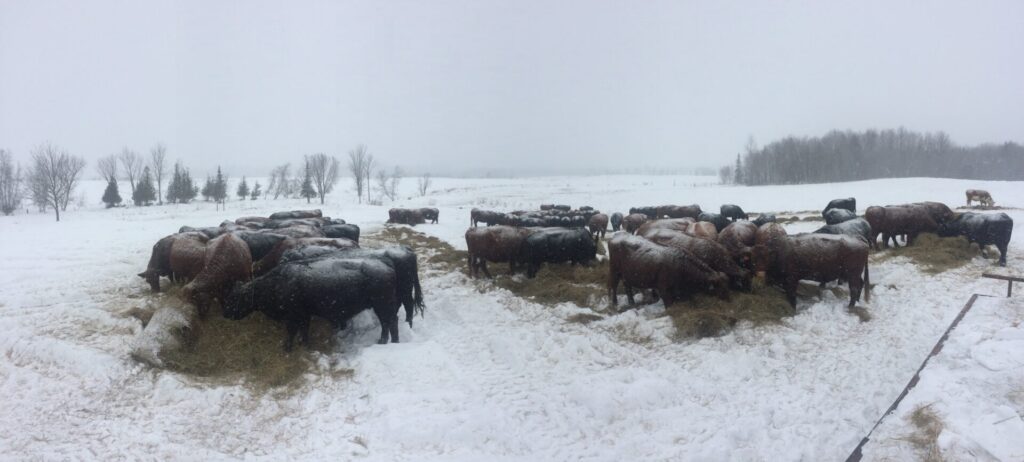
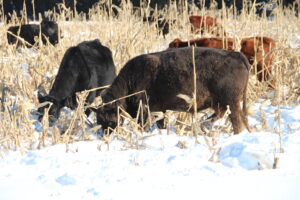
After the growing season, dry cows are grazed on stockpiled pasture before being moved to corn residue on a neighbour’s property. From around Christmas to early-mid February, they are moved to standing corn and finally, bale grazing until mid-April when they go to calving pastures. In the calving pastures, the cows are fed bales on the ground every other day. As they calve, they are moved to their regular pasture where they are rotationally grazed throughout the growing season. Calving season lasts from the end of April until early July. To address any challenges with mud the family is building a high-density wintering yard with a bed pack on sand where the cattle can be moved in the event of thaws, although they expect that good rotations should limit the use of it.
This year, they are working on installing permanent, energy-free winter watering systems across the farm to allow better access to winter water, in the event that there is not enough snow available to satisfy the animals’ requirements and to reduce the distance animals currently have to walk to water. They are also aiming to directly market more of their beef and increase the number of breeding bulls being sold.
Jacob stresses the importance of having the correct herd genetics to graze year-round. He suggests that producers purchasing bulls should think about the goals of their operation and look for bulls from farms that share the same values and production systems. He encourages visiting the farms before buying bulls, if possible. In addition to this, he also suggests that producers shouldn’t be afraid to cull cows that aren’t performing for them.
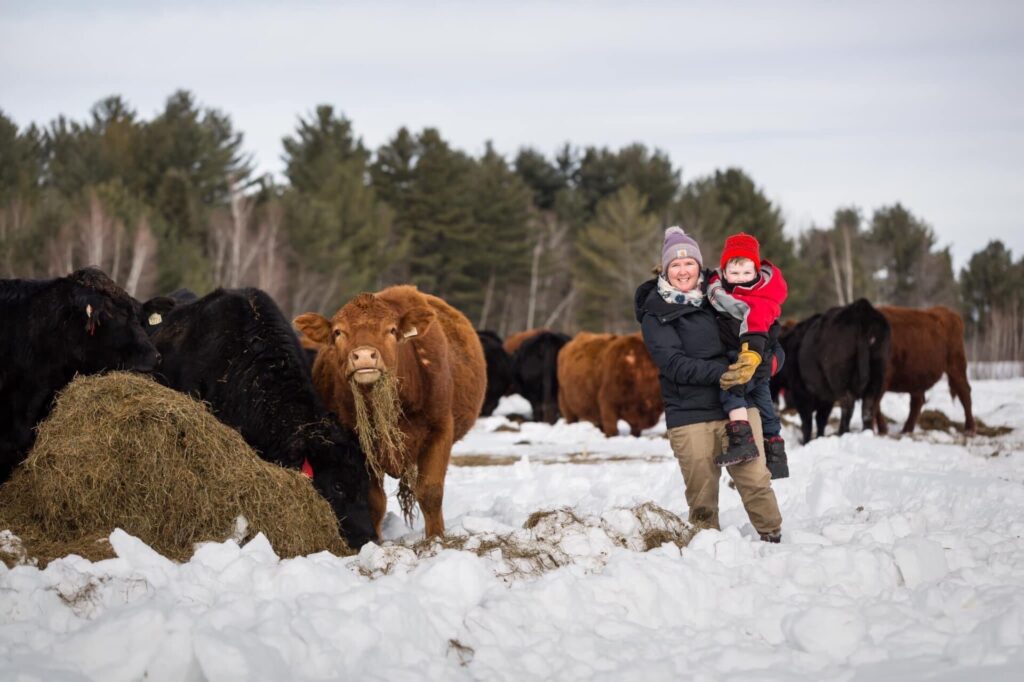
“If they aren’t working for you, they end up costing you money compared to selling them, Jacob says. “They are taking the place of a cow that would work better for your situation.” For their system, they require their cows to breed back and raise a calf every year.
Variable weather is a challenge that the Morin family encounters; sometimes the snow comes earlier than expected or frost comes later. When grazing corn residue on neighbouring cropland they wait until after the ground is frozen to prevent damage to the field. Jacob says, “It’s a matter of being observant and adaptable and that every year is a learning experience; it’s all part of the process.”
For more information about fall and winter grazing options, visit the BCRC’s recently updated Extended Grazing topic page.
This post was developed in collaboration and with the expertise of staff at Perennia Food and Agriculture, based in Nova Scotia.
Click here to subscribe to the BCRC Blog and receive email notifications when new content is posted.
The sharing or reprinting of BCRC Blog articles is welcome and encouraged. Please provide acknowledgement to the Beef Cattle Research Council, list the website address, www.BeefResearch.ca, and let us know you chose to share the article by emailing us at info@beefresearch.ca.
We welcome your questions, comments and suggestions. Contact us directly or generate public discussion by posting your thoughts below.